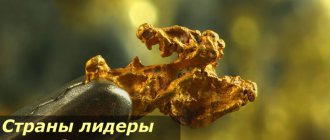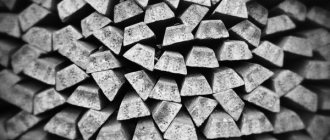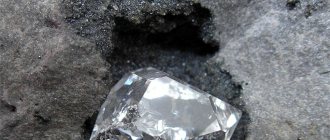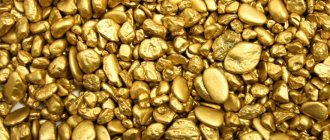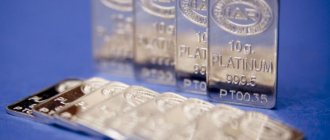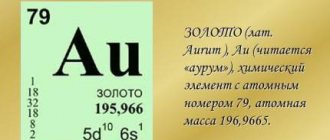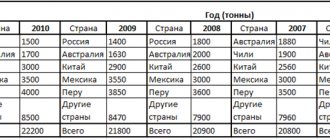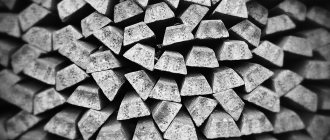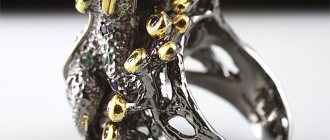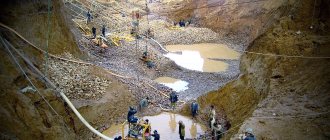Silver is a noble metal with a characteristic silvery-white color. It has been known since ancient times and is mined on different continents. The metal is popular in jewelry, medicine, various industries and industries.
- Physical properties
- Cyanidation
What does silver look like in nature?
In nature, it looks far different from what it looks like in a jewelry store. Even in the form of a nugget, a piece of almost pure metal, identifying it as a precious find is not so easy because of the deposit of dark gray sulfide, often with a pinkish tint. It can also resemble a coil of tangled wire or a piece of dry moss, or be in the form of a branching thread-like formation - a dendrite. And it will all be rusty or brownish in color due to the iron hydroxide coating it.
However, silver is most often found not in nuggets, but in the form of ore - a natural mineral raw material, a combination of minerals and bedrock that looks more like stones than metal.
In the case of silver, the compounds can be:
- With gold - electrum. Lamellar formations or dendrites, light yellow, white, greenish, with a metallic sheen, opaque.
- With sulfur - argentite. Solid mass, plates or crystals iron-black, blackish-gray, with a metallic sheen, opaque.
- With lead - galena. Cubic crystals and solid masses, lead-gray with a dull metallic luster, opaque.
- With arsenic - it will make you sad. Solid masses, scarlet, crimson-red, reddish-gray, darken in the light, with a diamond shine, translucent.
- With antimony - pyrargyrite. Granular inclusions, plaque, dendrites, purple-red, with a diamond semi-metallic luster, translucent, translucent.
Jewelry delights
The use of lunar metal in jewelry fashion is understandable and justified. The discreet beauty of the metal allows you to wear silver jewelry with almost any clothing; reasonable prices make such jewelry accessible to many.
How to decorate silver
There are different coatings to highlight the jeweler's idea. This:
- Rhodium plating is the coating of a product with the thinnest layer of rhodium. As a result, the decoration always remains light and shiny. Many connoisseurs of silver products believe that this shine is unnatural. For those who wear silver, such products are useless for protection against damage.
- Blackening. Some jewelry requires an "antique look." So a layer of “niello” (a mixture of copper, sulfur, and silver sulfides) is applied to the product.
- Oxidation. Preventive and controlled oxidation of jewelry. A layer of silver oxide is applied to its surface, the product darkens slightly and evenly, but the metal does not oxidize during wear.
- Gilding. The oldest way to decorate products made from our precious metal. A thin layer of gold is applied to the surface. However, gold-plated products require careful care and operation.
Chemical and physical properties
The physical properties of the noble metal are primarily important for production. Due to its high density, pure silver is a fairly heavy substance with a brilliant white color.
Compared to other metals, it has high:
- ability to reflect (making mirrors);
- thermal conductivity;
- electrical conductivity (parts for electrical equipment);
- density, ability to withstand heavy loads.
Among precious metals it differs:
- low melting point;
- high hardness, wear resistance (contact elements of computing equipment);
- softness and plasticity (jewelry making).
The main chemical property of silver as a precious metal is its ability to undergo various types of reactions. It dissolves well in nitric and concentrated sulfuric acid and mercury. It darkens from contact with hydrogen sulfide (including on the human body), reacts to iodine (decorations, cutlery lose their attractive appearance), while in the ground, it is converted into chloride compounds and dissolves.
From Macedonski to Sapkowski
In the troops of Alexander the Great, military leaders were sick less often than privates. But both the food and the conditions during the hikes were the same for everyone. The reason for good health (as medical historians suggest) is in the dishes. The rank and file ate from tin plates, while the military leaders were given silver plates.
Our Russian ruble is inextricably linked with silver. No, there is currently no precious metal in ruble and other consumable coins. But the coin got its name from the word “chopping.” In Ancient Rus', silver ingots or rods were in circulation; they were called hryvnias. A piece was cut off from them (corresponding to the price of the product), and it was called a ruble.
Mystical powers have always been attributed to the precious metal. Protection from any evil spirits (even vampires and werewolves, who could only be killed by silver weapons), from the evil eye and other horrors of the night.
Those who have read Sapkowski's books about the witcher Herald (or played computer games based on the book) know: the witcher's sword was made of pure silver metal. After all, the Rivan’s profession was the destruction of all kinds of evil spirits.
The process of silver formation in nature
On the surface of the earth, metal is formed during the simultaneous decomposition of sulfur, arsenic and antimony ores and their reduction with a variety of organic compounds.
Moreover, it can take any shape with the exception of a solid mass. Thus, intricate thread-like patterns are formed on pieces of coal. But silver is unstable in such conditions; it quickly turns black and, under the influence of temperature and precipitation, transforms into various compounds.
Underground, most minerals are formed from magma. Due to the tightness at the moment of crystallization, they do not have any special beauty. This is how metal ores, which include silver, are formed.
Another thing is hydrothermal vein deposits. These underground voids, formed by hot aqueous solutions and composed of crystals of quartz, carbonate and lead sulfide, become the site for the extraction of silver wire.
How are silver veins found?
An external sign indicating the presence of a silver vein in the rock is a scattering of rust-colored stones on the flat top of the mountain. This is one way to identify a deposit.
Satellites of silver
Invariably accompanying this metal in vein deposits are argentite, calcite, sulfur, arsenic and antimony compounds of nickel, cobalt, etc.
Australian mining industry
The island nation ranks fourth in the world in terms of the amount of silver mined. Last year, local entrepreneurs produced almost 55.4 million ounces of this resource. It is worth noting that in Australia the mining industry is developing at a fairly rapid pace. The first mine was built by local residents in 1840 in Tasmania (Reed-Rosbury). The valuable resource was mined using a closed method from lead, zinc and gold.
The main deposits are concentrated in the southwest of the mainland - in the state of Western Australia. The largest mines are located near the cities of Kalgoorlie
BHP Billiton is a leading silver and lead mining company in Kirrington, western Queensland. In 2015, the company received approximately 32.12 million ounces of the resource. Currently, BHP Billiton mines and produces about 43% of the resources in the entire territory of Australia.
The second large mine is considered to be Mt. Isa in Queensland. Here, mining companies extract deposits of silver ore using a closed method. The Mac Arthur River mine is the third most important. It produces about 15% of all Australian iron.
It is also worth noting the giant companies Xstrata ADR and Minmetals Recources. They own small deposits in the western lands (South Wales and Broken Hill).
Where is silver found in nature?
In nature, the noble metal is found as an admixture of gold-silver, copper and lead-zinc ores. In the earth's crust its content can reach 1 gram per ton - this is most often than all precious metals, and in sea water - 0.00004 g/t.
Types of deposits
In general, there are two types of deposits. These are the silver mines themselves. The share of silver is at least half of the total volume of metals mined. The largest of them are located in Mexico.
There are also silver-bearing deposits, where silver is a small part of the total production. The largest deposits of polymetallic ores are located in Australia, Japan and the USA.
Silver samples
There can be no absolutely pure silver. No matter how carefully it is made, it still contains some amount of impurities. Typically this is most often copper, but nickel, bismuth, iron, lead and antimony are also found. To make special solders, cadmium and zinc are added to the silver composition.
Naturally, the need arises to somehow distinguish alloys of such a precious metal by purity and the presence of impurities. Historically, this problem found its solution in applying a mark to the surface of a silver product indicating the percentage of the base metal - fineness (for example: one kilogram of 925-grade silver contains 925 grams of silver).
It is clear that over such a long period of use in different countries, various samples were applied: from 325 to 1000. There are even unofficial (fake) samples that are often used by scammers (825). However, currently in Russia the following numerical expressions of the percentage of silver are considered officially recognized:
- The alloy of 800 and 830 samples is intended for the manufacture of cheap jewelry and cutlery.
- 875 standard is suitable for decorating interiors, dishes, and making a number of jewelry.
- 925 is sterling silver, from which the vast majority of jewelry sold is made; coins, signs, and interior items are also made.
- 960th - the most expensive jewelry, highly susceptible to deformation.
- 999th – solder – material for technical use, in the form of ingots intended for storage.
Extraction methods
There are four methods of mining:
- Mine - underground. The deposit is developed using a gallery system.
- Quarry - above ground. Mining is carried out in massive trenches.
- Borehole - excavation of ores to the surface using a drill.
- Marine - work below sea level.
In old times
In ancient mines, rock extraction vaguely resembled a combination of modern mining and open pit methods. The extraction consisted of the following: the rock was heated using fires and then sharply cooled. With the advent of explosives, the appearance of mines began to evolve towards the appearance of modern underground mines.
Modern methods
Currently, silver is mined from deposits mainly underground, using the mine method, open-pit mining is also used, and the borehole mining method is increasingly being used.
2029: World silver reserves are drying up
For centuries, silver was the main material for making money.
Today, almost exclusively commemorative, collectible and commemorative coins are minted from it. Silver has always been a relatively rare metal. At the same time, due to its color, shine, ductility, malleability, electrical and thermal conductivity, oxidation resistance and other utilitarian and aesthetic properties, it is extremely widely used by humans. For centuries, silver has been used to mint coins and medals, make jewelry, it is used in electrical engineering, in photography, silver chloride is used to coat radar surfaces, in optics, silver fluoride single crystals are used to generate a laser beam, silver acetylide is used as an initiating explosive, silver phosphate is used in glassmaking, silver iodide is needed for climate control (as a rain-forming agent), and so on, and so on, and so on. The uses for silver are endless.
Meanwhile, the frequency of new silver mine discoveries is decreasing. In the mid-1980s there was a peak, the highest point on the graph of new proven reserves of silver. Then this figure only fell (to 60% by 2011). Today, silver is found in nature much less frequently than it has ever been found before. Of course, humanity still has a huge reserve of already mined silver for recycling. In recent years, the metal mined for the first time makes up no more than 20-30% of the silver used in all branches of production, science and craft. The rest is recycling. However, demand continues to rise, and the supply of silver available for mining or recycling is increasingly difficult to match. In many cases, silver can be replaced by aluminum, copper or rhodium, but silver is still needed, and in huge quantities. Exploration of new reserves (due to their rarity) is becoming more and more expensive and at the same time less successful. Thus, we come to a contradiction: silver is increasingly in demand, but exploring its deposits is becoming less and less profitable.
Already, the world economy is experiencing a shortage of silver. By 2029, the difference between the need for silver and its availability will become critical. Perhaps this situation will spur programs for the industrial development of metal asteroids. It’s not that it’s cheaper than continuing exploration on Earth, on the contrary, it’s many times more expensive, but investing in fundamentally new industries makes investors more willing to take risks; in such investments, the emotional component of the motive is more important, and in addition, they promise significant reputational and image gains . Traditional silver mining, despite its extreme need for civilization, will gradually wither away if the current world economic system (not primarily oriented toward profit) is maintained. The latter is supported, for example, by the following: as of today, BHP Billiton, the largest company in the world mining this metal (at least 25% of all global production), receives its main profits from the extraction of completely different minerals (bauxite, oil, gas, copper , manganese, iron ore, uranium, nickel); the same situation applies to other major silver miners; and although the valuation of the silver reserves at their disposal is constantly growing, there has been no corresponding increase in the shares of their silver mining divisions, and experts find investments in silver mining questionable in terms of long-term profitability.
You might be interested in:
Recycling of heavy-duty military batteries.
What happens next to the mined silver?
The next stage of silver production is the separation of the metal from the ore in two possible ways: cyanidation or amalgamation.
In the first case, the entire mined rock is treated with a cyanide alkali solution until it is completely dissolved. Then filter. Add zinc powder. The precipitate that falls is fused. The resulting alloy is sent to a specialized plant to be completely purified from impurities.
In the second method, crushed ore is passed through a mercury solution. Silver reacts with mercury and forms a semi-liquid substance. To extract the metal, mercury is squeezed out, and the resulting solid residue, melted into ingots, is also sent for final purification.
Methods for separating silver from ore
To extract silver, the ore, present in the form of large pieces, is first thoroughly crushed. After which the resulting fraction with dimensions of no more than 5-6 mm is subjected to enrichment using one of the following methods.
Cyanidation
One of the most common ways to isolate a precious mineral is to expose the mineral to cyanide (hydrocyanic acid compounds) together with oxygen to obtain a silver-containing solution. From which, through filtration and sedimentation, silver is deposited at the bottom of the container.
But that is not all. The resulting mass is treated with sulfuric acid to remove unnecessary impurities, and then washed, filtered, evaporated, and melted. As a result of a long technological process, finished silver bars are obtained that are sent for refining.
Amalgation
A process mastered over two thousand years ago and remains relevant to this day. The combination of silver and mercury forms a wet mixture, which is then squeezed out and evaporated. Thus obtaining a solid amalgam, again sent for cleaning to special factories.
Pyrometallurgical method
It should be noted that most of the silver produced in the world (four-fifths of the total amount) is a by-product of the processing of complex ores. The process of pyrometallurgy produces silver-containing compounds of copper, lead and zinc. Using the Parkes, Pattison and cupellation processes, the precious metal is separated from the rest of the chemical elements. Consistently using electrolysis, deposition and annealing.
Grinding and flotation
It is extremely inefficient to use the initially mined ore directly as a raw material, so it is first crushed and floated - separated from the waste rock using a liquid.
Refining
The production of pure silver is called refining, which successively includes a number of listed technological processes:
- Heating in a crucible furnace, carried out to get rid of impurities.
- Pouring the resulting melt into molds - anodes.
- Electrolysis in a solution of nitric acid containing silver nitrate. Since the anodes have already been obtained, stainless steel strips serve as cathodes in this process.
- Melting and casting into ingots.
Areas of application
Each of the physical and chemical properties of silver has found its application in industry and medicine, manufacturing and jewelry.
The ability to withstand heavy loads is used in the manufacture of contact elements in computer technology, electrical engineering and radio electronics.
A special place is occupied by nuclear technology and the defense industry, where silver is used in uranium enrichment.
High thermal and electrical conductivity is in demand in the manufacture of electrical contacts and conductors in precision instruments.
Neutron radiation indicators take advantage of silver's ability to become radioactive.
The ability to reflect is used in the production of mirrors. Photosensitivity is also used by the glasses of “chameleon” glasses and the entire photo and film industry in the production of film.
A colloidal solution of this metal has strong bactericidal properties, which is used by pharmacists in the production of medicines, and by industry in the manufacture of medical devices.
Using silver nitrate, forensic scientists take fingerprints; silver iodide in microscopic quantities causes precipitation. The addition of silver makes the bells and strings sing. And jewelry made from this noble metal can outshine any other!
Star preferences for lunar metal
Astrologers have always associated silver with our satellite the Moon. The purity, whiteness, secrecy and discreetness of the precious metal cannot but be associated with the same qualities of the Moon.
For zodiac signs, lunar metal is acceptable and useful. However, it will have the greatest influence on the signs of Water (these are Pisces, Scorpios, Cancers - their night ruler, the Moon). The “Wolf Sun,” as some peoples call the Moon, will provide water signs with subtle intuition and the ability to get around “sharp corners.”
Air signs will also receive the support of the night luminary. Just remember to take a break from lunar decorations sometimes.
We recommend: ALUMINUM - the roads it chooses
Earth and Fire signs can be treated with silver. But they are not recommended to constantly wear jewelry made of precious metal.
Leading countries in production
Today, global silver production amounts to more than 20,000 tons per year, most of it in the leading countries:
- Mexico (5900 t/y)
- Peru (about 4,200 t/y)
- China (more than 3400 t/y)
- Australia (1900 t/y)
- Russia (more than 1600 t/y)
The richest deposits
According to information provided by the US Geological Survey, the largest reserves of silver are: Peru (120 thousand tons), Australia (about 85 thousand tons) and Poland (about 85 thousand tons). The potential of Canada, Germany and Norway is rich in this regard. The Sukhoi Log field in the Irkutsk region is the largest undeveloped reserve in Russia.
Deposits in Russia, compared to the rest of the world, are distinguished by the highest concentration of silver in the ratio of gram of metal per ton of rock.
In the world
Mexico is developing about 200 mines on its territory, the largest of which are in Las Tores (Guanajuato state) and La Encantada (Coahuila state) with deposit volumes of 4.3 and 3.2 million tons of ore, respectively, as well as mines in the states Hidalgo, Zacatecas and Chihuahua with a total production volume of 20% in the country.
In the DPRK, this is the Ying region, which produces 35% of the state's reserves. Next comes Fuwan (Guangdong Province) - this deposit is highly profitable due to the high concentration of silver.
Peru has many small mines, producing 17% of global production. The largest is San Rafael, Eastern Cordillera - about 27% of the country's reserves. Australia - Kirrington, western Queensland. The volume of production at the field is about 43% of the resources of the entire territory.
In Russia
Among the richest deposits operating in the Russian Federation, the following are recognized:
- Lunnoye, Dukat and Goltsovskoye, Magadan region (30% of the country’s production);
- Forecast - Yakutia;
- Ozernoye and Kholodninskoye - Buryatia.
Five large silver mining companies in Russia
- Polymetal Corporation: 800,000 per year, mines of the Khabarovsk Territory and deposits of the Magadan Region, 80% of production.
- Chukotka GGK: Kupol and Dvoinoye fields in Chukotka.
- Millhouse Corporation: Highland Gold Mine.
- .
- .
Precious metal mining in Russia
Silver is mined in Russia where its concentration is sufficient for industrial production. The quantity is enough to satisfy our own needs and sell metal abroad to other countries. Now there are more than 100 mines operating in the country, which are located in 20 regions of the Russian Federation. Statistics can tell which of them are the most productive. Dukat and Lunnoye account for almost 25% of the production of the entire Ural region. Silver reserves in Russia are sufficient to produce more than 1 thousand tons annually.
Almost half of the country's precious metal is produced. Its main activity is mining. The company also conducts exploration work throughout Russia. Other enterprises extract silver as a by-product during the processing of other metals. Russian deposits have reduced argentum content per ton of ore when compared with most foreign ones.
The industry is developing every year, although it is not one of the most profitable for the country. Mining and processing enterprises are gradually beginning to introduce new technologies into the production process. Russia's average annual production is 500−600 tons.
What things and materials can you get silver from?
Precious metal is found in many objects around us. There is especially a lot of it in old things made back in the USSR: tableware, as well as trays and candelabra, Soviet awards, glass Christmas tree decorations of that time, photographic plates and other photographic items.
From radio components and circuits
Soviet-made radio components and circuits are rich in silver, especially in relays and microswitches. From them alone, up to 2-3 grams of high-purity metal can be isolated.
More ways
Nowadays, silver is mined not only in mountain deposits, but also in urban areas. There are large industrial enterprises specializing in the secondary processing of the photosensitive emulsion layer of photographic materials and x-rays.
From the associated effluents of this process, silver is captured in volumes comparable to its extraction from a profitable mine. This way, metal that has already been used once gets a second life.
Pros and cons of mining at home
Extracting metal at home always has a certain degree of risk (working with acids, for example). From the point of view of material enrichment, we must admit: this is not economically profitable, since it is time-consuming and requires a certain amount of reagents, equipment and knowledge.
The main advantage: a high-quality product - silver, the purity of which no manufacturer can guarantee you.
Refining is a method of obtaining pure metal
You can obtain pure metal using refining, a procedure for purifying silver in several stages. It can be done at home if you know some of the subtleties of the technology.
Various technological and jewelry scraps are used for cleaning.
Refining goes through 3 stages: diluting the metal in nitric acid, hardening, fusion and purification.
The following materials are used:
- glass and melting containers;
- Nitric acid;
- scales;
- filters;
- power unit;
- plastic bottle;
- stainless steel fork;
- insulating tape;
- brass stick.
The procedure must be carried out in a room with good ventilation. Silver is placed in acid diluted with water. As a result of the chemical reaction, silver nitrate will be obtained.
Silver is isolated using copper. It is a catalyst for the process, so pieces of copper are added to the solution. From time to time, take out the pieces and shake off the plaque into a jar. Copper will be added to the silver nitrate by dissolution.
The silver cement will settle to the bottom of the vessel. The solution is passed through coffee filters. Wash the sediment with clean water at least 5 times and then dry it naturally.
By heating the silver cement evenly in the crucible, the individual pieces will be formed into a single piece.
Metal of the highest standard is obtained in an electrolytic bath, into which a cut plastic bottle can be adapted.
A strip of pure silver is welded to a block of silver cement, placed in a tea filter and attached to a brass stick, which will serve as an anode. It is located above the bathtub.
The handle of the fork is wrapped with electrical tape, and the bent end is hung on the edge of the container. The cable from the power supply goes to the plug at one end, and to the brass stick at the other.
Pour in a solution of silver nitrate diluted with water. As a result of the electrolytic reaction, the walls of the bath are covered with silver crystals, which are then fused into one piece. The result will be 999 silver.
How to extract silver at home
- Method one: the silver-containing element is immersed in a mixture of hydrochloric and sulfuric acids. After dissolving it, zinc dust or shavings are added and allowed to settle until a sediment forms, which is washed with water and dried.
- Method two: a little hydrochloric acid is added to the aqueous electrolyte solution. The part sinks to the bottom until a curd-like sediment appears. The precipitate is left to settle for 24 hours, then the solution is filtered and a little hydrochloric acid is added. The acid is removed, the precipitate is washed with water and dried at 120 °C.
- Method three: to remove a thin layer of silvering, it must be treated with a solution of potassium iodide and metallic iodine preheated to 50 °C.
Historical reference
Even in ancient times, people discovered silver and attributed noble meaning to it. Archaeologists, conducting excavations, have discovered silver items all over the world: Scandinavia, South America, the Middle East, etc. Silver items were also found among the ancient Egyptians before the rise of pharaohs and dynasties.
Silver was believed to have magical and healing properties. In ancient times, people believed that silver represented the Moon, and alchemists included the metal as a chemical element in their experiments.
